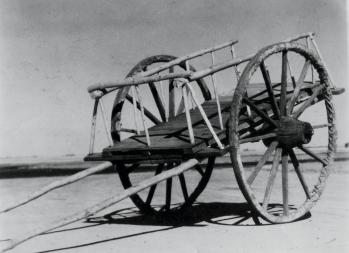
The Red River Cart played a prominent role in the development and settlement of the North-West Territories and Saskatchewan. The two-wheeled carts were used extensively in eastern Canada soon after European arrival in the early 1600s, but did not arrive on the prairies until the early 1800s. As fur traders and explorers pushed west into the settlement of Red River, Manitoba, it became apparent that not all of their travel could be conducted by York boat or canoe. By 1801 plans were undertaken to build an all-wooden, two-wheeled cart held together with green buffalo hide that tightened exceptionally well after drying. The two wooden wheels were approximately 1.5 metres in diameter, and the open box could hold loads of up to 450 kg. The entire cart had two long poles protruding from the axles, which were lashed to a mule, horse, or oxen. Because the carts were made entirely of wood they could easily be repaired along the trail, could float across shallow streams and be pulled through swamps or bogs, and were exceptionally sturdy. They were very easy to operate, and it was not uncommon to have one driver manage a brigade of carts at one time. At the peak of their existence it is estimated that as many as 2,500 Red River Carts traversed trails in a single year through what is now Saskatchewan. During that time the carts carried more than 600 tonnes of freight for the Hudson's Bay Company (HBC) alone. The resistance to use axle grease, for fear of dust collection, led to the wheels producing a high-pitched squeal that could be heard several kilometres away. One of the routes that experienced the majority of traffic from Red River Carts was the Carlton Trail: throughout the 1860s the HBC reported on average 300 carts making one trip per season on this trail, carrying supplies, provisions, and furs. Over time, the carts were replaced by steamboats that traveled along navigable waterways such as the North and South Saskatchewan Rivers, and by locomotives on the railways.
James Winkel